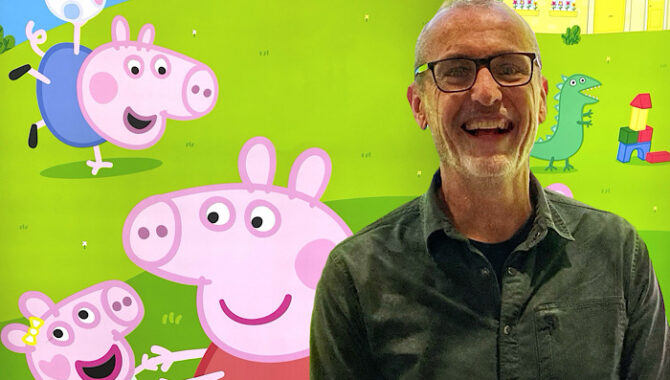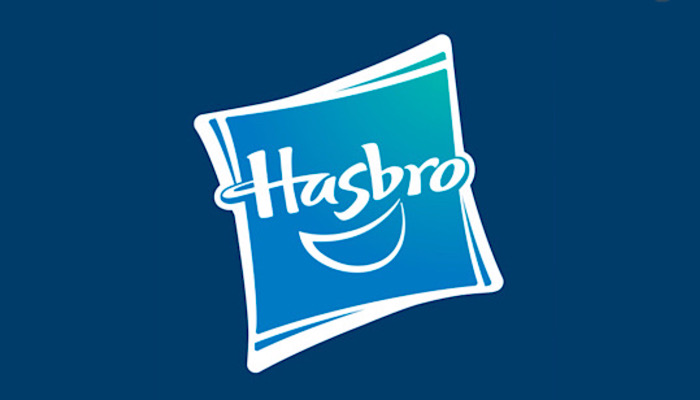—-
To stay in the loop with the latest features, news and interviews from the creative community around licensing, sign up to our weekly newsletter here

“Sometimes A plus B totals more than A plus B!” Pete Ridgewell on Hasbro’s licensed consumer products.
This might seem like a philosophical question: who is the mighty Pete Ridgewell?!
Pete: Hmmm. I’m married with two children, and I’d describe myself as a collaborative problem-solver who’s passionate about product development and bringing creative ideas to life. I love to do the whole product-development process. I don’t like to pigeonhole myself into one area… Who else? I love my surfing! In fact, that’s driven me to the coast here in the UK. I live right on the beach in a little place called Pagham, near Bognor Regis. Professionally, I’m Hasbro’s Senior Product Development Manager for Licensed Consumer Products, Europe and Iberia. I head up Hasbro’s EMEA hardlines, but I also work directly with the German and Iberian teams.
Perfect. And if I want to put a picture in here and say, “This kind of thing!” what product would work well?
A specific product? One that I think is great is an amazing product we did with Carrera for Nerf recently… It was just great from beginning to end. The NERF Blasting Car. It’s a remote-control car onto which you can mount a NERF blaster! You can shoot up to ten darts from it; you can make it move backwards, forwards and sideways. It comes with a little target too. It’s an amazing product – and a total partnership; Carrera did a great job on that.

Carrera do a great job on everything! We’ve interviewed Frank Tiessen a couple of times. People can read interviews with him here and here. You were a licensee first were you not, Pete? How did you get into the industry?
Initially, I got into toys almost by accident! This is going back quite a long time… I’d been travelling for a reasonable period and was trying to get back into work, so I was with an agency. I was doing interview practice at various companies… One of which was Hasbro. I hadn’t contemplated toys as a job but I went along. I was very relaxed because I didn’t think this was where I wanted to be. As the interview process went on, I realised that I DID want to be in toys… And that made me more and more nervous.
Ha! That must’ve been awful!
It was, because by the end I really, really wanted it. Fortunately, I got over the nerves, got over the line, got into toys – and absolutely loved it. I was with Hasbro the first time for eight or nine years on the development side. You really learn how to do things properly at Hasbro. After that, I got a role at Flair Leisure Products. And that was amazing because then I went from being a smaller cog at Hasbro to a bigger cog at Flair. Flair was flexible, fast and loose – and you have to do absolutely everything! You take the idea from thought to production via everything in between. That was a real revelation. It also turned out to be a great way to make contacts in the industry.
And that must be useful from a design point of view, to have two such vastly different working styles early in your career…
Yes, especially when you realise that instead of there being one way of doing it, there’s just any way to get it done. You’ve got to think on your feet, make adaptations and make it happen. So Flair was a really great opportunity for me. After that came to an end, and post COVID, I did two years working independently – another great opportunity. Working for yourself brings a mixture of panic and joyousness…
Panic and joyousness! You’d fit in at Brands Untapped… Why panic?
Because I was doing the work I love, but always worried: was it going to continue forever? So that period was amazing. It allowed me to do what I really wanted and made me go out and look for work and make connections and put myself out there in a big way. That led to more of the connections I’ve found useful since Hasbro found me again.

Let’s talk about that! Had you thought about doing licensing before Hasbro found you?
No, I hadn’t contemplated the licensing side of it at all. I went in with an open mind because it sounded really interesting. It did sound like an evolution because, throughout my career, I’ve gone from doing a lot of the detail with a few projects to doing more projects with less detail for me personally – but having more influence over them. And I think that’s the natural next step; it’s a progression. We work across hundreds and hundreds of projects with many, many partners and I love that influence. I don’t really want to go into the detail. I love the upfront, the steering, the ideation, the partnership… I love knowing ‘This is where it needs to go.’
Presumably you occasionally hit something and DO need to go into the detail of things?
Well, yes – and in a way that scratches the occasional itch. And my different backgrounds often mean I know how to solve some of the problems, which is great. I still enjoy all of those “what if…” questions. “What if we could do this?”
“What if this could go here?”, “What if we push that further?” So I love pushing our partners to do more or do better. I also love seeing those sparks of ideas become a reality.
And how often does your team have the idea and go to your partners versus your partners having the idea and coming to you?
Increasingly so. What I’ve tried to do is have ideas going in. We’re a very small team but, for our key partners, we brainstorm and have specific ideas ready. And then we’re ready for our brainstorms with our partners and we’ll always push them to have some more, to go a little further. Sometimes we have storylines ready, sometimes we have ideas for products that could fit a line…
Other times, we look at a partner’s back catalogue to see what could come from under the counter to work with new storylines. That’s really paid off over the years. But we’re also trying to organise more blue-sky, white-space ideation… We also work with external designers. Triclops come to mind as an example; they’re great guys.
They’ll be thrilled to hear you say that, I’m sure! Billy’s interviewed them a few times; I’ll link to pieces in our sister magazine, Mojo Nation, here and here. I’m curious to know… If I asked you how you stay creative, could you say?
Stay creative? Good question. I think it’s just a muscle, isn’t it? You just keep doing it.
I think it is, yes…
From a toy point of view, I guess it’s part of a funnel. I encourage people to check what’s out there, see what’s cool, connect with people, observe and communicate. But then, maybe it’s just something I enjoy doing because I’m always thinking that A plus B can sometimes total more than just A plus B! Do you know what I mean? I’ve seen this, I’ve seen this, I’ll put those two things together and it will be more than the sum of its parts.
I know exactly what you mean! And I’ll give you a recent example, actually; I’ll link here to an interview I did with Warmies. They do plush you heat up in the microwave for aches and pains. You’ve seen this kind of thing before. But plush you heat plus quality plus licensing – it’s VASTLY greater than the sum of its parts!
Interesting, yes! I was also going to say that I love brainstorming… I could do brainstorms all day – I love them! I like the freedom of just talking a bit of rubbish, then openly sparking ideas off each other if you’re in the right environment.

This might be a point of contention because I can’t stand brainstorming!
Oh?! I assumed you liked them! You can’t stand them?
Well, I think brainstorming’s deeply flawed with the wrong people, the wrong room or the wrong attitude. What do you to make them work?
Ah! Well, I agree! There are a couple of things… You’ve got to have a structure. And you’ve got to feel like you can safely say rubbish! Just let it come out and not be embarrassed. You also have to feel that you’re encouraged to build on someone else’s ideas and vice versa. You must encourage other people to build on yours. And it is a little bit challenging…
You’ve got to park your ego a bit. When I do it, I always try to build on someone else’s thought as soon as they say it. Just that is often enough to get them to say something else. It doesn’t even matter what they say, you just have to build on it and see where things go.
I agree with you! And when you say it has to be structured… How so?
It’s got to be in two parts. You’ve got to have the crazy part and then you’ve got to step back and have the kind of reality-check part. Not necessarily a full reality check… But if people try and do both parts in one go, there’re are no ideas…
Well, I’m glad I asked because it sounds like you and I are on the same page. I’ve done an article on better brainstorming; I’ll link to it here. But you’re exactly right: if the smallest bit of ego creeps into a brainstorm, it’s a waste of time. If the loudest voice wins, then it’s worse than a waste of time! Do you do your brainstorms in person or online?
We can do both, but often across Microsoft Teams. So even if we’re online, we’ve got a format that works the same way. We put words and pictures in and throw it all in together on Teams. Then we review them together. Build, build, build… And then a filter afterwards. But yes, you’ve got to have a trusting environment. And just a word on that because the people at Hasbro – the hardline team, the softline team, the creative team – they’re fantastic. It’s really great to work with the commercial teams as well. It’s a great partnership.
Brilliant. I knew you’d give me an interesting interview, Pete so thank you! Before we wrap this up, tell me: if you were sitting in your office, what would be the most interesting object there?
Ha! It’s got too much stuff; it’s everywhere. I love to have things around that I’ve worked on in the past. One thing that comes to mind goes back to Triclops again, funnily enough. I’ve got a lovely Urban Vinyl Roots Morph that sits behind me. All their designers loved it. It wasn’t a smash-hit commercial success, but it’s one of my favourite objects.
Brilliant. That was great! Thank you, Pete. Thanks for making time.

Enter your details to receive Brands Untapped updates & news.